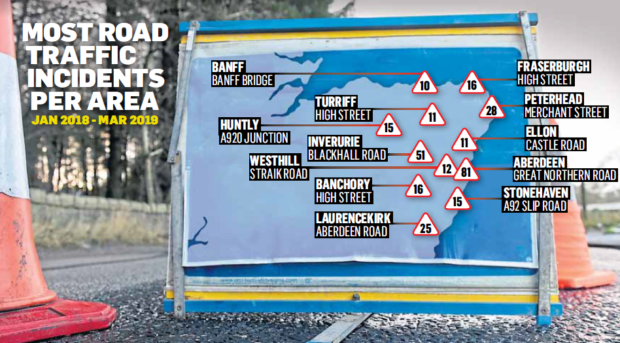Thousands of crashes and other dangerous incidents are being reported on the north-east’s roads every year, according to new figures.
Police data obtained by The Press and Journal shows that some stretches are experiencing more than one road traffic incident per week.
These include collisions between vehicles, as well as reports of motorists suspected of dangerous or drink-driving, among other offences.
Using the most recent statistics, almost 740 separate roads across the force’s North East division – which covers Aberdeen, Aberdeenshire and Moray – had at least three such incidents over the last 15 months.
These alone total more than 5,000, with the final figure – including roads with fewer than three police reports – likely to be far higher.
Great Northern Road in Aberdeen had the largest number of incidents, with 81 between January 2018 and March 2019.
Blackhall Road in Inverurie was the only street in the top ten outside of Aberdeen, with 51 road traffic incidents over the period.
Road safety charity IAM RoadSmart has said authorities must take notice of the figures.
Policy and research director, Neil Greig, said: “This analysis gives valuable insights for local drivers about the highest-risk routes in the north-east where they need to take extra care.
“More importantly these lists show where resources need to be targeted for maximum benefit.
“This should include enforcement resources as well as engineering improvements.
“On main routes like the A90, removing right turns and improving junctions to full grade separation is our top priority for investment.”
A number of north-east towns’ high streets were the worst in their areas for road traffic incidents, including Fraserburgh, Turriff and Banchory.
Other locations, including Huntly and Stonehaven, had more accidents at junctions linked to trunk roads than on residential or commercially-focused streets.
Ewan Wallace, head of transportation for Aberdeenshire Council, said the local authority is experiencing a “continual reduction” in the number of people injured on the roads.
He added that council officers collate data on crashes and other road traffic incidents in order to better judge which areas need the most attention.
“The work that our road safety team carries out is intelligence-led, whereby we act on facts and analyse data to identify patterns,” he said.
“That allows us to allocate resources where they will be most effective, be it an engineering or educational intervention.”
Transport Scotland said it is working towards an “ultimate vision” of having no fatalities on the roads.
It pointed to initiatives such as its £2 million rollout of average speed cameras on the A90 between Dundee and Stonehaven as methods improving road safety.
Road policing Chief Inspector Simon Bradshow said: “Road safety is a key priority for Police Scotland and we’re committed to improving safety on the roads across the region.
“We routinely carry out patrols using marked and unmarked vehicles to deter and detect offences and speak to drivers and other road users about their behaviour in order to educate them as to the potential consequences.”
Subsequent to publication of this story, it has been brought to our attention that due to an anomaly in the way Police Scotland record the addresses of accidents, roads which are also the location of police stations are likely to be shown as having more incidents than actually occur there. This includes Great Northern Road in Aberdeen, Blackhall Road in Inverurie and Merchant Street in Peterhead.










